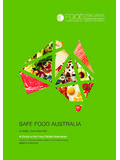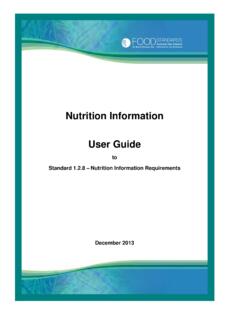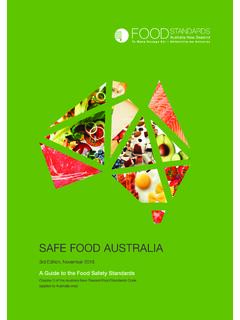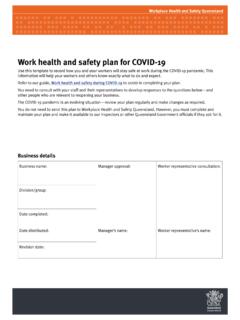Transcription of Appendix 6: Cleaning and sanitising surfaces and utensils
1 173 AUSTRALIA NEW ZEALAND FOOD STANDARDS CODE CHAPTER 3 (AUSTRALIA ONLY)APPENDICESFOOD STANDARDS AUSTRALIA NEW ZEALAND SAFE FOOD AUSTRALIA6 Appendix 6 Appendix 6: Cleaning and sanitising surfaces and utensilsThis Appendix includes information on Cleaning and sanitising eating and drinking utensils and food contact surfaces . It is for information only and businesses are not legally obliged (under the food safety standards) to clean and sanitise at the temperatures or times specified and sanitising are separate procedures, and sanitising is distinct from is a process that removes visible contamination such as food waste, dirt and grease from a surface, usually using water and detergent. During the Cleaning process, microorganisms will be removed but the Cleaning process is not designed to destroy is a process that destroys microorganisms, reducing the numbers present on a surface to a safe level. This is usually achieved by the use of both heat and water, or by specific sanitising chemicals (detergents are generally not sanitisers).
2 Sterilising is a process designed to destroy all microorganisms including microorganisms that have formed a protective coat (spores). The standards do not require eating and drinking utensils and food contact surfaces to be and sanitising should usually be done as separate processes. A surface needs to be thoroughly cleaned before it is sanitised, as sanitisers generally do not work well in the presence of food residues and six recommended steps for effective Cleaning and sanitising are:1. Pre-clean: scrape or wipe food scraps and other matter off surfaces and rinse with Wash: use hot water and detergent to remove grease and food residue. (Soak if needed.)3. Rinse: rinse off detergent and any loosened Sanitise: use a sanitiser to destroy remaining microorganisms (refer to manufacturer s Final rinse: wash off the sanitiser if necessary (refer to manufacturer s instructions).6. Dry: allow to drip dry or use single use and sanitising can be done manually ( using spray bottles or sinks), or using dishwashers or other specialised equipment, depending on the size and number of items to be cleaned and sanitised.)
3 An example of a simple double sink arrangement that may be suitable for small amounts of utensils or small equipment is illustrated GUIDE TO THE FOOD SAFETY STANDARDS THIRD EDITION NOVEMBER 2016 FOOD STANDARDS AUSTRALIA NEW ZEALAND SAFE FOOD AUSTRALIAFOOD STANDARDS AUSTRALIA NEW ZEALAND SAFE FOOD AUSTRALIA6 Appendix 6 Figure: Example of Cleaning and sanitising using a double sink. (The 2nd sink could alternatively have water at 77 C or hotter if no sanitiser chemical is used.) CleaningThe thorough Cleaning of eating and drinking utensils and food contact surfaces is a critical step before sanitising . Food businesses must use a Cleaning process that ensures the utensil or food contact surface looks clean, feels clean and smells cleaningFor effective Cleaning , the following factors should be considered: Warm to hot water is generally needed Heated water will help remove grease or fat but the temperature should not be so hot that it bakes food residue onto the surface.
4 For example, 54 C to 60 C has been recommended (Mallman et al 1947) for washing utensils as higher temperatures tend to bake on food residues. Detergents should be appropriate for the task For example, household detergents may suffice for small-scale manual washing, but specialised detergents may be needed depending on the residue to be removed and the equipment being used. Detergents containing sanitisers are not required If such a detergent is used, advice on whether it can clean and sanitise to the required standard should be sought from the manufacturer or supplier. The use of a mechanical washer for large volumes of washing up is preferred Studies have found that mechanical washing is consistently more effective than washing up by hand ( Sigua et al 2011). Cleaning without water may be necessary in some situations. Whatever method is used it must achieve the intended outcome: that is, that the utensil or surface looks clean, feels clean and smells NEW ZEALAND FOOD STANDARDS CODE CHAPTER 3 (AUSTRALIA ONLY)APPENDICESFOOD STANDARDS AUSTRALIA NEW ZEALAND SAFE FOOD AUSTRALIA6 Appendix 6 SanitisingSanitation of eating and drinking utensils and food contact surfaces should only be done after they have been thoroughly cleaned; otherwise it may not be effective.
5 sanitising can be achieved through the use of hot water, chemicals or other processes. Some examples are: soaking items in very hot water (see below) soaking items in diluted bleach (see below) saturating items with 70% alcohol applying a commercial food-grade sanitiser according to the manufacturer s instructions, with particular attention to the required concentration and contact sanitationFor effective sanitation, the following factors are important: All surfaces to be sanitised must be clean, since sanitisers generally do not work well in the presence of food residues or other soil. Sanitisers should be used at the correct concentration (too low or too high is not effective) and temperature and for the correct contact time. Ideally, details will be specified by the sanitiser s manufacturer. Using products with informative labels or product specification sheets will enable details of use to be easily checked. Some sanitisers require extended contact time to ensure pathogens are reduced to a safe level.
6 Diluted sanitisers often have a shorter shelf life than the concentrated form, so this should be checked before use, and a fresh batch made if needed. All surfaces to be sanitised should be completely covered with the sanitising solution, using a dip or spray. Special attention should be given to equipment with surfaces that are difficult to get at, such as stab mixers, blenders, meat slicers and can openers. Equipment may need to be dismantled to gain proper access to the surfaces that need to be sanitised. After sanitising , utensils and surfaces should be thoroughly dried. If used while still wet, there is a greater chance that they could pick up dirt or other contaminants. Air drying is preferable. If towels are used they should be clean, dry and ideally single use, because if they become contaminated they may then transfer pathogenic microorganisms between items. Tea towels should not be repeatedly used without washing and drying between uses.
7 Care should be taken not to re-contaminate sanitised utensils and equipment; for example by ensuring they are packed away with clean hands and stored in a clean and sanitary waterSanitation using hot water can be achieved manually ( in a sink) or mechanically ( with a dishwasher). The decision to use hot water should consider whether the items to be sanitised can withstand the sanitation temperature and whether the equipment used can produce the intended outcome. Whatever the method used it should be able to sanitise the utensil or surface so that it does not permit the transmission of infectious GUIDE TO THE FOOD SAFETY STANDARDS THIRD EDITION NOVEMBER 2016 FOOD STANDARDS AUSTRALIA NEW ZEALAND SAFE FOOD AUSTRALIAFOOD STANDARDS AUSTRALIA NEW ZEALAND SAFE FOOD AUSTRALIA6 Appendix 6 Manual sanitationThe method used for manual sanitation needs to ensure that utensils or food contact surfaces are exposed to a time temperature combination that ensures they are sanitised.
8 For example, the US Food Code 2013 requires utensils and food contact surfaces to be immersed in water at a minimum temperature of 77 C for at least 30 seconds. To achieve this, the sink may need to have a heating element or hot water delivered at a higher temperature. Australian Standard AS 4674-2004 Design, Construction and Fit-Out of Food Premises recommends that sinks used for sanitising deliver hot water of at least 80 water temperature may need to be monitored with a thermometer to confirm it remains hot enough for the whole sanitation period. Care should be taken to avoid scalding dishwashersBusinesses may choose to sanitise using a commercial dishwasher or glasswasher. There is no prescribed method for sanitation by dishwasher; however the information below is provided for 4674-2004 generally recommends that dishwashers and glasswashers: are capable of washing and rinsing in one continuous operation when used for sanitising : do not contain brushes where hot water is used to sanitise, only operate on the sanitising cycle when the water is at sanitising temperature the water temperature used in the sanitising rinse cycle, combined with the time that the utensils are rinsed in water at that temperature (or a combination of time and temperature in wash, rinse and sanitising rinse and/or drying cycles) is sufficient to ensure that the utensils are standards that specify temperatures include: the US Food Code 2013 and associated standard NSF 3: Commercial Warewashing Equipment (NSF International 2012), which require.
9 A minimum wash and rinse temperature of 74 C for stationary rack, single temperature dishwashers minimum 66 71 C wash temperature and 82 C rinse temperature for other dishwasher types(a list of certified dishwashers is available at search Certified Products and Systems) the European standard for commercial dishwashing with one-tank dishwashers (DIN Standard 10512), which requires 60 65 C wash (in the wash water tank) and 80 85 C rinse (in the rinse tank or boiler) where there is no sanitiser chemical NEW ZEALAND FOOD STANDARDS CODE CHAPTER 3 (AUSTRALIA ONLY)APPENDICESFOOD STANDARDS AUSTRALIA NEW ZEALAND SAFE FOOD AUSTRALIA6 Appendix 6 Generally, commercial dishwashers should be able to use high temperatures (greater than 80 C) in their sanitation rinse cycles. The program results in the cumulative buildup of heat in the item that affects sanitation. Businesses should use the program that the manufacturer has specified for sanitising . See also Best practice use of dishwashers, may be useful to monitor the surface temperature of utensils and equipment.
10 The US Food Code requires that the food utensils and equipment being sanitised reach a final surface temperature of 71 C if hot water mechanical operations are used for surface temperature of items in the dishwasher could be checked, for example, using the following methods: indicator temperature-sensitive tape applied to items in the dishwasher these tapes change colour irreversibly once exposed to certain temperatures and can be easily applied to plates or utensils a maximum-registering thermometer attached to items with tape or an elastic band a laser thermometer directed at items as soon as the dishwasher is finished and dishwashersDomestic dishwashers may be used by small food businesses ( some home-based businesses) where only small volumes of dirty eating and drinking utensils are generated. Domestic dishwashers consistently perform better than washing dishes by , while domestic dishwashers use lower rinse temperatures than commercial dishwashers, the cycles are longer to compensate for these lower there is no prescribed method for sanitation with domestic dishwashers specified in the standards, the hottest and longest dishwasher program is recommended ( hygienic wash or equivalent heavy-duty, high-intensity settings).













